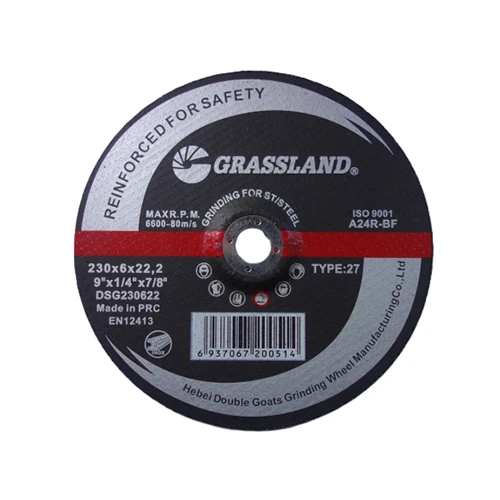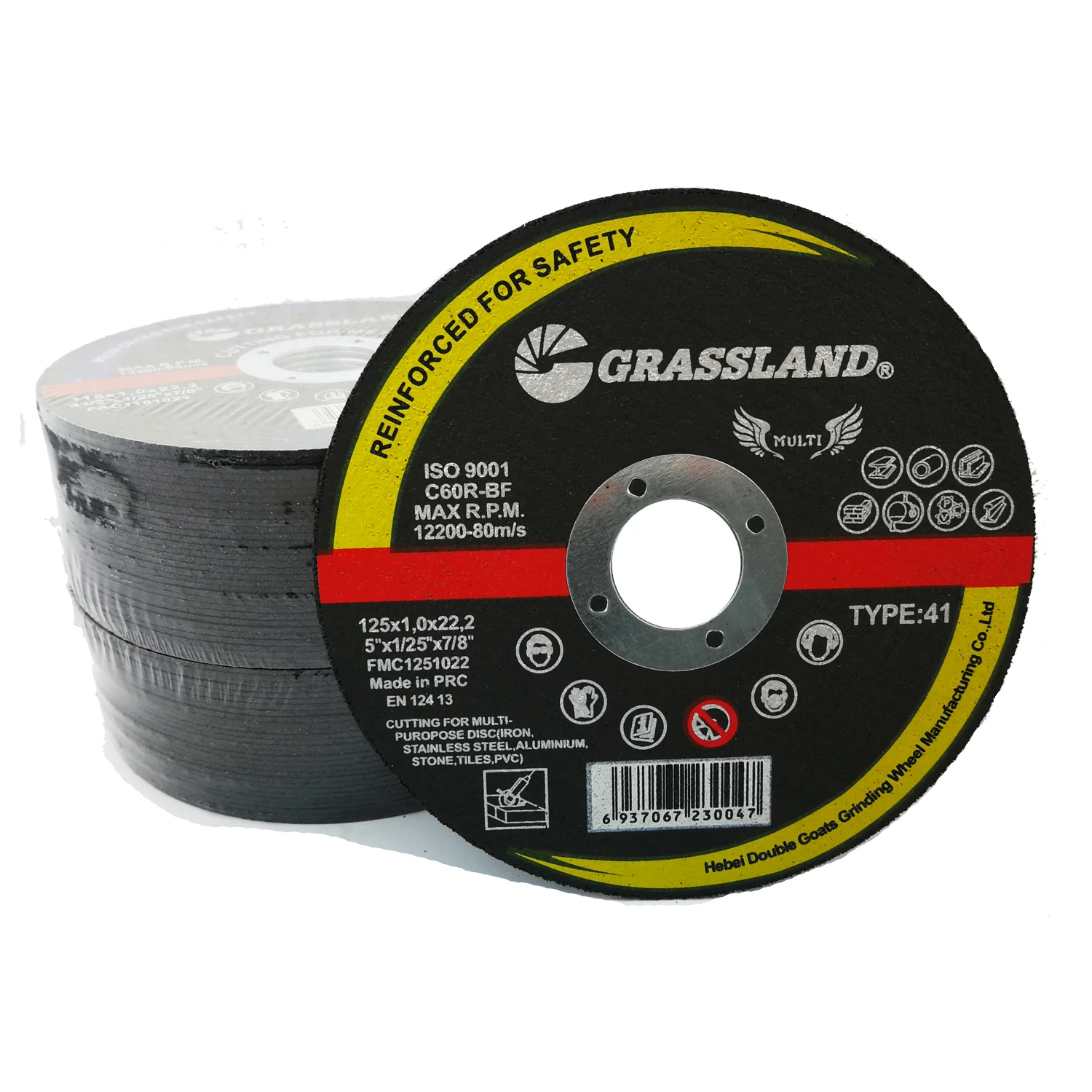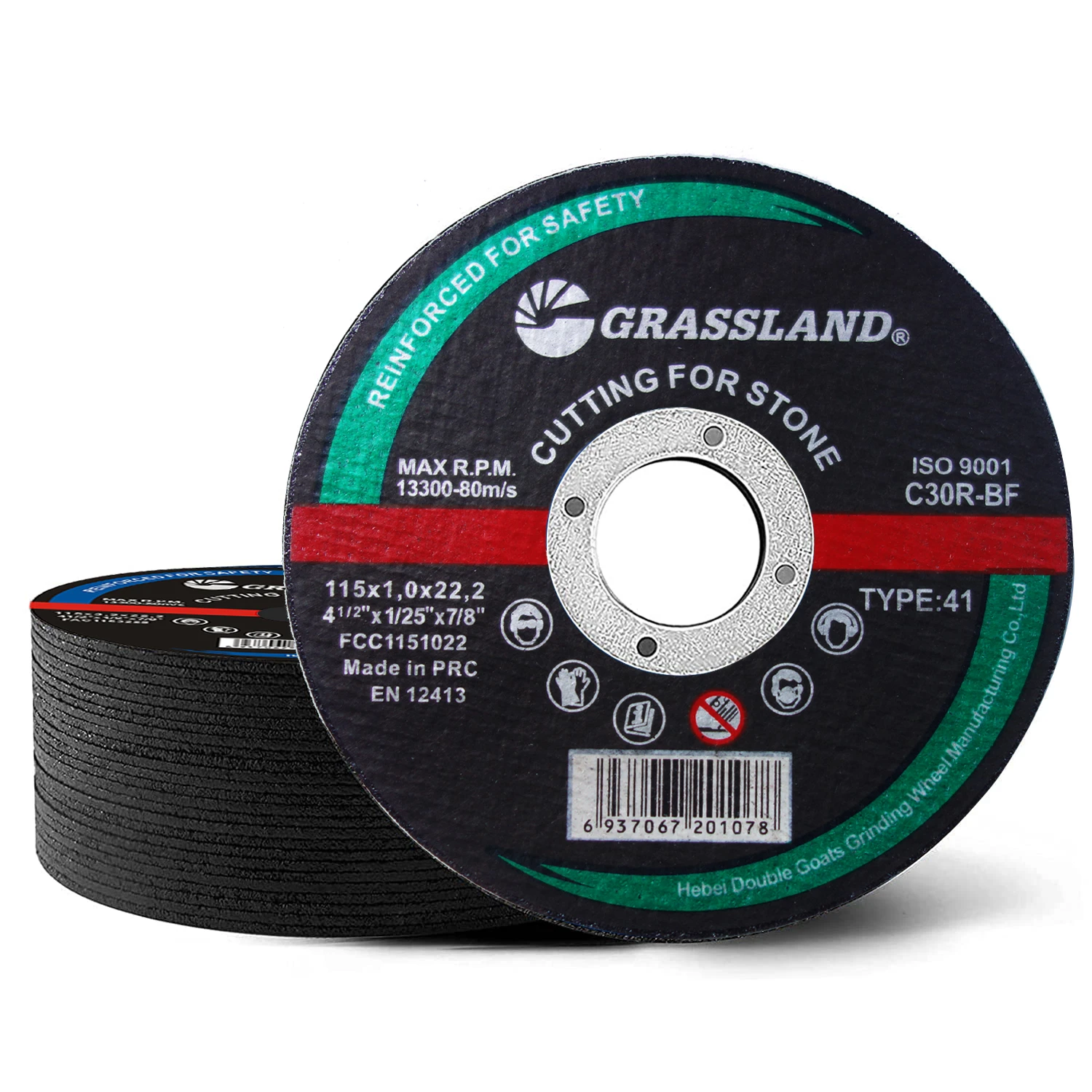Precision Abrasives for Industrial Applications: The 40 grit flap disc Explained
In high-performance industrial environments, the selection of appropriate abrasive tooling is paramount for achieving optimal material removal rates, surface preparation, and operational efficiency. The 40 grit flap disc stands as a critical component in aggressive material removal and preparatory tasks across various sectors. Engineered for durability and efficacy, these discs are designed to tackle demanding applications, offering significant advantages over traditional grinding wheels in terms of finish, operator comfort, and reduced re-work. This comprehensive overview delves into the technical aspects, application versatility, and strategic importance of the 40 grit flap disc for B2B decision-makers and technical professionals.
Related products such as the 40 grit flap wheel, specifically the 4.5 flap disc 40 grit variant, are essential for processes requiring heavy stock removal, weld blending, deburring, and rust removal, particularly when working with ferrous and non-ferrous metals. Understanding the nuanced capabilities of these abrasives is key to optimizing production workflows and enhancing overall project outcomes.
Manufacturing Process Flow of the 40 Grit Flap Disc
The production of a high-quality 40 grit flap disc is a multi-stage, precision-controlled process, ensuring consistency, performance, and safety. This meticulous manufacturing flow adheres to stringent international standards, guaranteeing product reliability for demanding industrial applications.
Process Steps:
- Abrasive Cloth Preparation: Jumbo rolls of high-performance abrasive cloth, typically Zirconia Alumina or Ceramic Alumina for a 40 grit flap disc for metal applications, are precision-cut into uniform rectangular flaps. The abrasive grain distribution and backing material (e.g., polyester-cotton blend) are critical at this stage.
- Backing Plate Production: Fiberglass or high-strength plastic backing plates are molded under controlled conditions. These plates provide structural integrity and absorb vibration. For 4.5 inch discs, the standard diameter and arbor hole dimensions are strictly maintained.
- Adhesive Application: A specialized, high-strength resin adhesive, designed for thermal stability and aggressive bonding, is applied evenly onto the backing plate surface. The adhesive choice directly impacts flap retention and disc longevity.
- Flap Attachment & Configuration: The pre-cut abrasive flaps are strategically overlapped and attached to the adhesive-coated backing plate. The fan-like radial arrangement ensures continuous exposure of fresh abrasive material during use, preventing premature dulling and maximizing service life.
- Curing & Hardening: The assembled discs undergo a controlled curing process in industrial ovens. This involves precise temperature and duration cycles to fully cross-link the resin, creating an extremely robust bond between the flaps and the backing plate.
- Trimming & Balancing: After curing, excess material is trimmed, and each disc is balanced to minimize vibration during high-speed operation, enhancing operator comfort and safety.
- Quality Control & Testing: Each batch undergoes rigorous testing to meet international standards such as ISO 21948 (Abrasive Products – Flap Discs and Flap Wheels) and ANSI B7.1 (Safety Requirements for the Use, Care, and Protection of Abrasive Wheels). Key tests include:
- Adhesion Strength: Verifying the bond integrity between flaps and backing.
- Burst Strength: Testing disc integrity at rotational speeds significantly exceeding maximum operating RPM (e.g., up to 1.5 times the Max RPM).
- Material Removal Rate (MRR): Measuring efficiency on specific metal alloys.
- Service Life: Durability under simulated operational stress.
- Balance Testing: Ensuring smooth, vibration-free operation.
- Packaging: Final inspected discs are securely packaged to prevent damage during transit and storage.
This rigorous process ensures that the 40 grit flap disc delivers consistent performance, extended service life, and adherence to safety protocols for diverse target industries including petrochemical, metallurgy, shipbuilding, automotive, and heavy fabrication. Advantages in typical application scenarios include enhanced energy saving through efficient material removal, superior corrosion resistance due to improved surface preparation, and reduced heat buildup during aggressive grinding.
Industry Trends in Abrasive Technology
The abrasive industry, particularly concerning products like the 40 grit flap disc, is continuously evolving, driven by demands for increased efficiency, improved safety, and sustainability. Key trends include:
- Advanced Grain Technologies: Development of next-generation ceramic and zirconia alumina grains with improved fracture toughness and self-sharpening capabilities, extending disc life and cutting speed.
- Smart Abrasives and IoT Integration: Emerging solutions involving embedded sensors for real-time monitoring of disc wear, temperature, and performance data, enabling predictive maintenance and optimized usage.
- Ergonomics and Safety: Focus on designs that reduce vibration, noise, and dust generation, enhancing operator comfort and mitigating occupational health risks. Lighter, more balanced designs for 4.5 flap disc 40 grit applications are a priority.
- Sustainability Initiatives: Growing demand for flap discs made with recycled content in backing plates or eco-friendly bonding agents, along with manufacturing processes that reduce energy consumption and waste.
- Application-Specific Optimizations: Tailored abrasive solutions for niche applications, such as specialized resin bonds for high-heat environments or specific backings for robotic grinding systems.
These trends underscore a move towards higher-performing, safer, and more intelligent abrasive solutions that directly impact the cost-effectiveness and environmental footprint of industrial operations.
Technical Specifications of a Standard 40 Grit Flap Disc
Understanding the precise technical parameters is crucial for selecting the correct 40 grit flap disc for specific material removal tasks. The following table details typical specifications for an Angle Grinder Metal 4-1/2" 40 Grit Flap Disc Wheel.
| Parameter | Specification | Unit/Description |
|---|---|---|
| Disc Diameter | 115 (4-1/2") | mm (inches) |
| Arbor Hole Diameter | 22.23 (7/8") | mm (inches) |
| Grit Size | 40 | Coarse |
| Abrasive Grain Type | Zirconia Alumina (ZA) / Ceramic Alumina (CA) blend | High-performance, self-sharpening |
| Backing Material | Fiberglass / Plastic | Rigid, durable, vibration-damping |
| Flap Angle (Conical/Flat) | Type 29 (Conical) / Type 27 (Flat) | Optimal for aggressive removal / flat surface finishing |
| Max RPM | 13,300 | Rotations Per Minute |
| Bonding Agent | Phenolic Resin | Heat-resistant, strong adhesion |
| Weight per disc (approx.) | 90-110 | grams |
| Application Suitability | Steel, Stainless Steel, Cast Iron, Non-ferrous Metals, Welds | Material compatibility |
| Safety Standards | ISO 21948, ANSI B7.1 | Ensures operational safety |
These specifications highlight the robust design and engineering behind each flap wheel 40 grit, ensuring it meets the rigorous demands of industrial grinding and finishing. The choice between Type 27 (flat) and Type 29 (conical) configurations of the 40 grit flap disc depends on the desired material removal aggressiveness and the contour of the workpiece.
Application Scenarios and Technical Advantages
The versatility of the 40 grit flap disc makes it indispensable in numerous industrial applications requiring aggressive material removal and surface preparation. Its technical advantages significantly contribute to operational efficiency and output quality.
Typical Application Scenarios:
- Weld Blending and Removal: Aggressively removes excess weld material and blends weld seams on steel and stainless steel fabrications, providing a smoother transition ready for finer finishing.
- Heavy Stock Removal: Ideal for removing large amounts of material from workpieces, such as shaping metal components or reducing casting flash.
- Deburring: Effectively removes burrs, sharp edges, and splinters from machined or cut metal parts, enhancing safety and subsequent processing.
- Rust, Paint, and Coating Removal: Quickly strips away old coatings, heavy rust, oxidation, and scale from metal surfaces, preparing them for new finishes or inspections.
- Edge Chamfering: Creates consistent chamfers on metal plates and profiles, a crucial step in preparing edges for welding or for safety.
Technical Advantages:
- Aggressive Material Removal: The coarse 40 grit abrasive ensures a high material removal rate, significantly accelerating rough grinding and deburring operations compared to finer grits.
- Improved Finish over Grinding Wheels: Unlike conventional grinding wheels, the flexible flap design of a 40 grit flap disc provides a more consistent, smoother finish, often reducing the number of subsequent finishing steps.
- Self-Sharpening Action: As flaps wear down, new, sharp abrasive grains are continuously exposed, maintaining consistent cutting performance throughout the disc's life. This extends the service life and reduces disc changes.
- Reduced Heat Buildup: The design promotes better airflow and heat dissipation compared to solid grinding discs, minimizing heat-induced discoloration and distortion of the workpiece.
- Lower Vibration and Noise: The inherent flexibility of the flap design absorbs more vibration, leading to a smoother operation, reduced operator fatigue, and a quieter working environment.
- Versatility: Capable of both heavy stock removal and producing a foundational finish in one tool, reducing tool changeovers.
- Enhanced Safety: Less prone to shattering compared to rigid grinding wheels, contributing to a safer work environment.
Vendor Comparison and Customization Solutions
When sourcing 40 grit flap discs, B2B purchasers evaluate vendors based on product quality, technical support, customization capabilities, and total cost of ownership. While specific vendor names are beyond the scope, a comparative framework is critical.
Key Comparison Factors for Flap Disc Vendors:
| Factor | High-Tier/Specialized Vendor | Standard/Commodity Vendor |
|---|---|---|
| Abrasive Grain Quality | Premium Ceramic/Zirconia blend, engineered for specific alloys | Standard Zirconia or Aluminum Oxide, general purpose |
| Backing Plate Durability | High-strength fiberglass/composite, superior heat & impact resistance | Standard fiberglass or plastic, adequate for light to medium duty |
| Bonding System | Advanced phenolic resin, optimized for minimal shedding, high heat | Standard resin, good for most applications, may have higher wear rate |
| Disc Life / MRR | Extended life (e.g., 20-30% longer), higher Material Removal Rate (MRR) | Standard life and MRR |
| Technical Support | Application engineers, on-site consultation, problem-solving expertise | Basic product information, limited application guidance |
| Customization Options | Extensive (size, grit blend, backing, flap density, specialized coatings) | Limited to standard variations |
| Certifications & Standards | ISO 9001, ANSI B7.1, EN 13743, supplier specific performance data | Meets basic safety standards |
Customized Solutions:
For specialized industrial applications, off-the-shelf 40 grit flap discs may not always provide optimal results. Leading manufacturers offer comprehensive customization services, including:
- Specific Abrasive Blends: Custom mixtures of grain types (e.g., Ceramic/Zirconia/Alumina blends) to optimize performance on exotic alloys or specific material hardnesses.
- Varied Backing Plate Materials: Selection of fiberglass, plastic, or even metal backings for enhanced rigidity, flexibility, or specific environmental resistance.
- Tailored Flap Density and Angle: Adjusting the number, overlap, and angle of flaps to control aggressiveness, finish quality, and disc longevity for specific robotic or manual applications.
- Unique Dimensions: Production of non-standard diameters or arbor hole sizes to fit specialized grinding equipment.
- Special Coatings: Application of top-coatings (e.g., grinding aid coats) to reduce heat buildup, prevent loading, and enhance abrasive life, especially on stainless steel and high-nickel alloys.
Engaging with a vendor capable of providing these tailored solutions ensures that the abrasive perfectly matches the application's unique demands, maximizing efficiency and minimizing operational costs.
Application Case Studies
Real-world applications demonstrate the tangible benefits of utilizing high-quality 40 grit flap discs.
Case Study 1: Heavy Fabrication Plant - Weld Blending on Structural Steel
A major structural steel fabricator faced challenges with inefficient weld removal and inconsistent surface finishes using traditional grinding wheels. The process required extensive post-grinding cleanup and often led to localized heat distortion.
- Challenge: Slow material removal, high heat input, poor finish requiring additional steps.
- Solution: Implementation of premium 4.5 flap disc 40 grit (Type 29, Zirconia Alumina) for all primary weld blending operations.
- Results:
- 25% Increase in Material Removal Rate: Aggressive 40 grit quickly removed excess weld.
- 40% Reduction in Finishing Time: The smoother finish from the flap disc eliminated one entire subsequent finishing step.
- Minimized Heat Distortion: Improved heat dissipation reduced warping of thin-gauge steel components.
- Extended Tool Life: Flap disc outlasted grinding wheels by 3:1 ratio, reducing changeovers.
Case Study 2: Automotive Component Manufacturing - Deburring Cast Iron Parts
An automotive parts supplier required efficient deburring of high-volume cast iron engine components. Manual deburring was labor-intensive and inconsistent.
- Challenge: Inconsistent deburring, high labor costs, risk of damaging precision surfaces.
- Solution: Automated robotic deburring utilizing specialized 40 grit flap wheel with a flexible backing.
- Results:
- 98% Consistency in Deburring Quality: Automated process ensured uniform edge finishing.
- 30% Reduction in Cycle Time: Aggressive cutting power of the 40 grit flap disc rapidly removed burrs.
- Reduced Rework: Minimal damage to critical dimensions, leading to fewer rejects.
- Significant Cost Savings: Automation and extended abrasive life led to an estimated 15% reduction in overall deburring costs.
Frequently Asked Questions (FAQ)
Q: What is the primary application of a 40 grit flap disc?
A: The 40 grit flap disc is primarily used for aggressive material removal, heavy stock grinding, weld blending, deburring, and rust/paint removal on various metals, including steel, stainless steel, and cast iron. Its coarse grit ensures rapid material removal.
Q: How does a flap disc compare to a grinding wheel?
A: Flap discs offer a more forgiving grind, produce a finer finish in fewer steps, generate less heat and vibration, and are generally safer due to less susceptibility to shattering. Grinding wheels are more rigid and designed for extremely aggressive, heavy-duty material removal where finish quality is less critical.
Q: Can I use a 40 grit flap disc on aluminum?
A: While a 40 grit flap disc for metal can be used on aluminum, coarser grits like 40 or 60 can sometimes load up quickly due to aluminum's ductility. For optimal performance on aluminum, specialized non-loading flap discs or specific grain treatments (e.g., stearates) are often recommended to prevent material buildup and ensure longer life.
Q: What does 'Type 29' or 'Type 27' refer to in flap discs?
A: These refer to the disc's profile. Type 29 (conical) has angled flaps and is ideal for aggressive material removal and contour grinding, providing a larger contact area. Type 27 (flat) has flat flaps and is suitable for flat surface grinding and finishing, offering maximum contact on flat workpieces.
Lead Time, Warranty, and Support Information
Our commitment to customer satisfaction extends beyond product quality to reliable logistics and comprehensive post-sales support.
- Lead Time & Fulfillment: For standard orders of 40 grit flap disc, typical lead times range from 3-7 business days for stock items. Larger volume orders or custom solutions may require 2-4 weeks. We maintain robust inventory levels and efficient logistics networks to ensure timely delivery, with expedited shipping options available upon request.
- Warranty Commitments: All our abrasive products, including the 40 grit flap disc for metal, are backed by a manufacturer's warranty against defects in materials and workmanship. This typically covers a period of 12 months from the date of purchase, provided products are stored and used according to recommended guidelines and safety standards (e.g., ANSI B7.1). Detailed warranty terms are available upon request.
- Customer Support: Our dedicated technical support team comprises experienced application engineers ready to assist with product selection, troubleshooting, and optimization for specific grinding applications. We offer phone and email support during business hours and can arrange on-site consultations for complex industrial challenges. Training sessions for proper use and safety protocols are also available to maximize the efficiency and longevity of our products.
Our goal is to be a trusted partner, providing not just superior abrasive products like the 40 grit flap wheel, but also the expertise and support necessary for your operational success.
References
- International Organization for Standardization (ISO). ISO 21948:2018. Abrasive products — Flap discs and flap wheels.
- American National Standards Institute (ANSI). ANSI B7.1-2017. Safety Requirements for the Use, Care, and Protection of Abrasive Wheels.
- Metal Finishing Magazine. "Advances in Abrasive Grain Technology." Vol. 120, No. 3, 2022.
- Journal of Manufacturing Processes. "Comparative Analysis of Abrasive Discs in Weld Grinding Operations." Vol. 45, pp. 288-295, 2021.
Post time:Sep - 02 - 2025

















